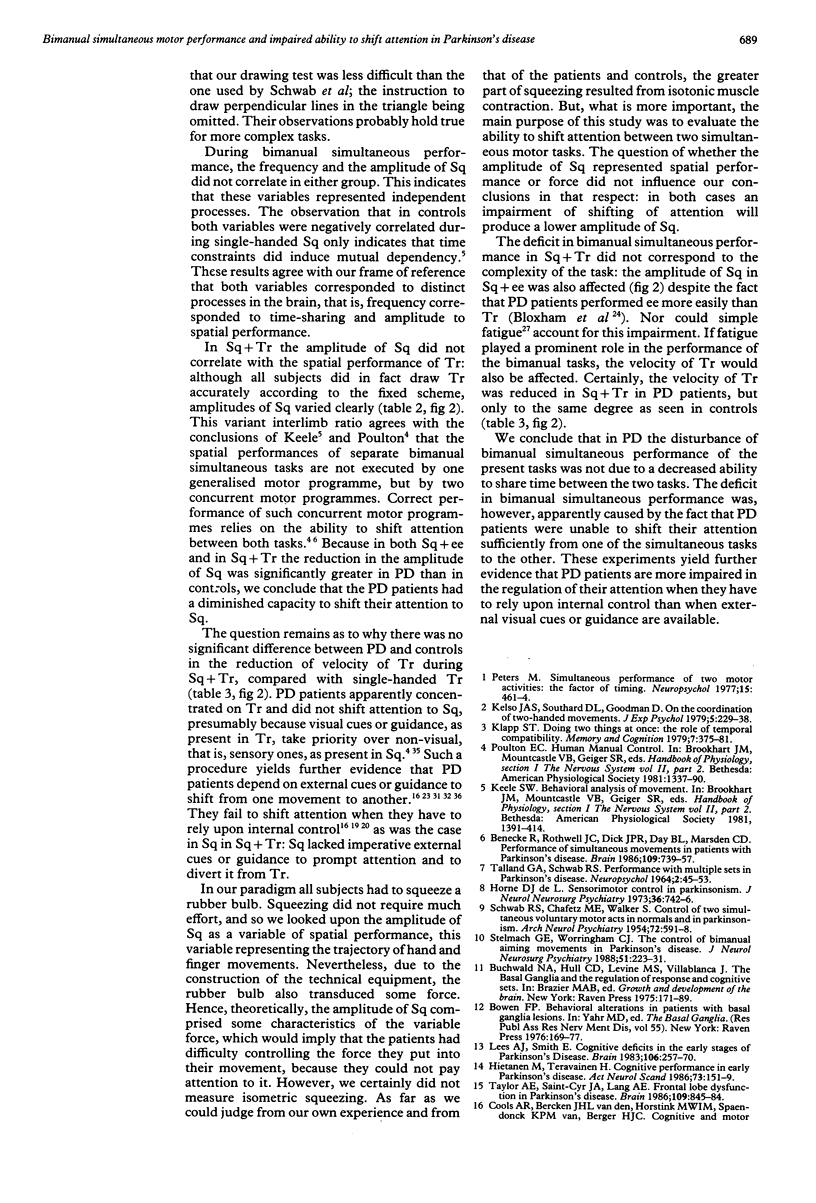Abstract
The ability to share time and to shift attention between bimanual simultaneous motor tasks were studied in 18 patients with Parkinson's disease (PD) and 19 age- and intelligence-matched controls. The task consisted of drawing triangles with the dominant hand and squeezing a rubber bulb with the nondominant hand. Motor performance was measured using the variables: amplitude of squeezing, frequency of squeezing and velocity of drawing triangles. After eliminating variance due to baseline differences in single-handed performance, the bimanual simultaneous performance of PD and controls turned out to be similar to the frequency of squeezing and the velocity of drawing triangles. The amplitude of squeezing, however, differed between the two groups: it was significantly reduced in PD. Arguably the disturbance in the bimanual performance of PD patients was not due to a disorder of time sharing, but to a decreased ability to shift attention from the visually cued task to the non visually cued task. The results agree with current evidence that PD patients are more impaired when they have to rely upon internal control for the regulation of shifting attention than when external cues are available.
Full text
PDF





Images in this article
Selected References
These references are in PubMed. This may not be the complete list of references from this article.
- Benecke R., Rothwell J. C., Dick J. P., Day B. L., Marsden C. D. Disturbance of sequential movements in patients with Parkinson's disease. Brain. 1987 Apr;110(Pt 2):361–379. doi: 10.1093/brain/110.2.361. [DOI] [PubMed] [Google Scholar]
- Benecke R., Rothwell J. C., Dick J. P., Day B. L., Marsden C. D. Performance of simultaneous movements in patients with Parkinson's disease. Brain. 1986 Aug;109(Pt 4):739–757. doi: 10.1093/brain/109.4.739. [DOI] [PubMed] [Google Scholar]
- Berger H. J., van Hoof J. J., van Spaendonck K. P., Horstink M. W., van den Bercken J. H., Jaspers R., Cools A. R. Haloperidol and cognitive shifting. Neuropsychologia. 1989;27(5):629–639. doi: 10.1016/0028-3932(89)90109-7. [DOI] [PubMed] [Google Scholar]
- Bloxham C. A., Mindel T. A., Frith C. D. Initiation and execution of predictable and unpredictable movements in Parkinson's disease. Brain. 1984 Jun;107(Pt 2):371–384. doi: 10.1093/brain/107.2.371. [DOI] [PubMed] [Google Scholar]
- Bowen F. P. Behavioral alterations in patients with basal ganglia lesions. Res Publ Assoc Res Nerv Ment Dis. 1976;55:169–180. [PubMed] [Google Scholar]
- Brown R. G., Marsden C. D. An investigation of the phenomenon of "set" in Parkinson's disease. Mov Disord. 1988;3(2):152–161. doi: 10.1002/mds.870030207. [DOI] [PubMed] [Google Scholar]
- Brown R. G., Marsden C. D. Internal versus external cues and the control of attention in Parkinson's disease. Brain. 1988 Apr;111(Pt 2):323–345. doi: 10.1093/brain/111.2.323. [DOI] [PubMed] [Google Scholar]
- Carter M. C., Shapiro D. C. Control of sequential movements: evidence for generalized motor programs. J Neurophysiol. 1984 Nov;52(5):787–796. doi: 10.1152/jn.1984.52.5.787. [DOI] [PubMed] [Google Scholar]
- Cools A. R., van den Bercken J. H., Horstink M. W., van Spaendonck K. P., Berger H. J. Cognitive and motor shifting aptitude disorder in Parkinson's disease. J Neurol Neurosurg Psychiatry. 1984 May;47(5):443–453. doi: 10.1136/jnnp.47.5.443. [DOI] [PMC free article] [PubMed] [Google Scholar]
- Flowers K. A., Robertson C. The effect of Parkinson's disease on the ability to maintain a mental set. J Neurol Neurosurg Psychiatry. 1985 Jun;48(6):517–529. doi: 10.1136/jnnp.48.6.517. [DOI] [PMC free article] [PubMed] [Google Scholar]
- Flowers K. A. Visual "closed-loop" and "open-loop" characteristics of voluntary movement in patients with Parkinsonism and intention tremor. Brain. 1976 Jun;99(2):269–310. doi: 10.1093/brain/99.2.269. [DOI] [PubMed] [Google Scholar]
- Flowers K. Lack of prediction in the motor behaviour of Parkinsonism. Brain. 1978 Mar;101(1):35–52. doi: 10.1093/brain/101.1.35. [DOI] [PubMed] [Google Scholar]
- Georgopoulos A. P., DeLong M. R., Crutcher M. D. Relations between parameters of step-tracking movements and single cell discharge in the globus pallidus and subthalamic nucleus of the behaving monkey. J Neurosci. 1983 Aug;3(8):1586–1598. doi: 10.1523/JNEUROSCI.03-08-01586.1983. [DOI] [PMC free article] [PubMed] [Google Scholar]
- Hietanen M., Teräväinen H. Cognitive performance in early Parkinson's disease. Acta Neurol Scand. 1986 Feb;73(2):151–159. doi: 10.1111/j.1600-0404.1986.tb03257.x. [DOI] [PubMed] [Google Scholar]
- Horne D. J. Sensorimotor control in Parkinsonism. J Neurol Neurosurg Psychiatry. 1973 Oct;36(5):742–746. doi: 10.1136/jnnp.36.5.742. [DOI] [PMC free article] [PubMed] [Google Scholar]
- Jensen A. R., Rohwer W. D., Jr The Stroop color-word test: a review. Acta Psychol (Amst) 1966;25(1):36–93. doi: 10.1016/0001-6918(66)90004-7. [DOI] [PubMed] [Google Scholar]
- Kelso J. A., Southard D. L., Goodman D. On the coordination of two-handed movements. J Exp Psychol Hum Percept Perform. 1979 May;5(2):229–238. doi: 10.1037//0096-1523.5.2.229. [DOI] [PubMed] [Google Scholar]
- Lees A. J., Smith E. Cognitive deficits in the early stages of Parkinson's disease. Brain. 1983 Jun;106(Pt 2):257–270. doi: 10.1093/brain/106.2.257. [DOI] [PubMed] [Google Scholar]
- Peters M. Simultaneous performance of two motor activities: the factor of timing. Neuropsychologia. 1977;15(3):461–465. doi: 10.1016/0028-3932(77)90099-9. [DOI] [PubMed] [Google Scholar]
- SCHWAB R. S., CHAFETZ M. E., WALKER S. Control of two simultaneous voluntary motor acts in normals and in parkinsonism. AMA Arch Neurol Psychiatry. 1954 Nov;72(5):591–598. doi: 10.1001/archneurpsyc.1954.02330050061010. [DOI] [PubMed] [Google Scholar]
- SCHWAB R. S., ENGLAND A. C., PETERSON E. Akinesia in Parkinson's disease. Neurology. 1959 Jan;9(1):65–72. doi: 10.1212/wnl.9.1.65. [DOI] [PubMed] [Google Scholar]
- Stelmach G. E., Worringham C. J. The control of bimanual aiming movements in Parkinson's disease. J Neurol Neurosurg Psychiatry. 1988 Feb;51(2):223–231. doi: 10.1136/jnnp.51.2.223. [DOI] [PMC free article] [PubMed] [Google Scholar]
- Taylor A. E., Saint-Cyr J. A., Lang A. E. Frontal lobe dysfunction in Parkinson's disease. The cortical focus of neostriatal outflow. Brain. 1986 Oct;109(Pt 5):845–883. doi: 10.1093/brain/109.5.845. [DOI] [PubMed] [Google Scholar]
- Wing A. M., Miller E. Basal ganglia lesions and psychological analyses of the control of voluntary movement. Ciba Found Symp. 1984;107:242–257. doi: 10.1002/9780470720882.ch13. [DOI] [PubMed] [Google Scholar]
- van Spaendonck K. P., Berger H. J., Horstink M. W., Jaspers R. M., Cools A. R. Cognitive performance in early Parkinson's disease. Acta Neurol Scand. 1987 Jan;75(1):74–75. doi: 10.1111/j.1600-0404.1987.tb07893.x. [DOI] [PubMed] [Google Scholar]



